Ammonia Fuel Could Revolutionize Zero-Carbon Shipping
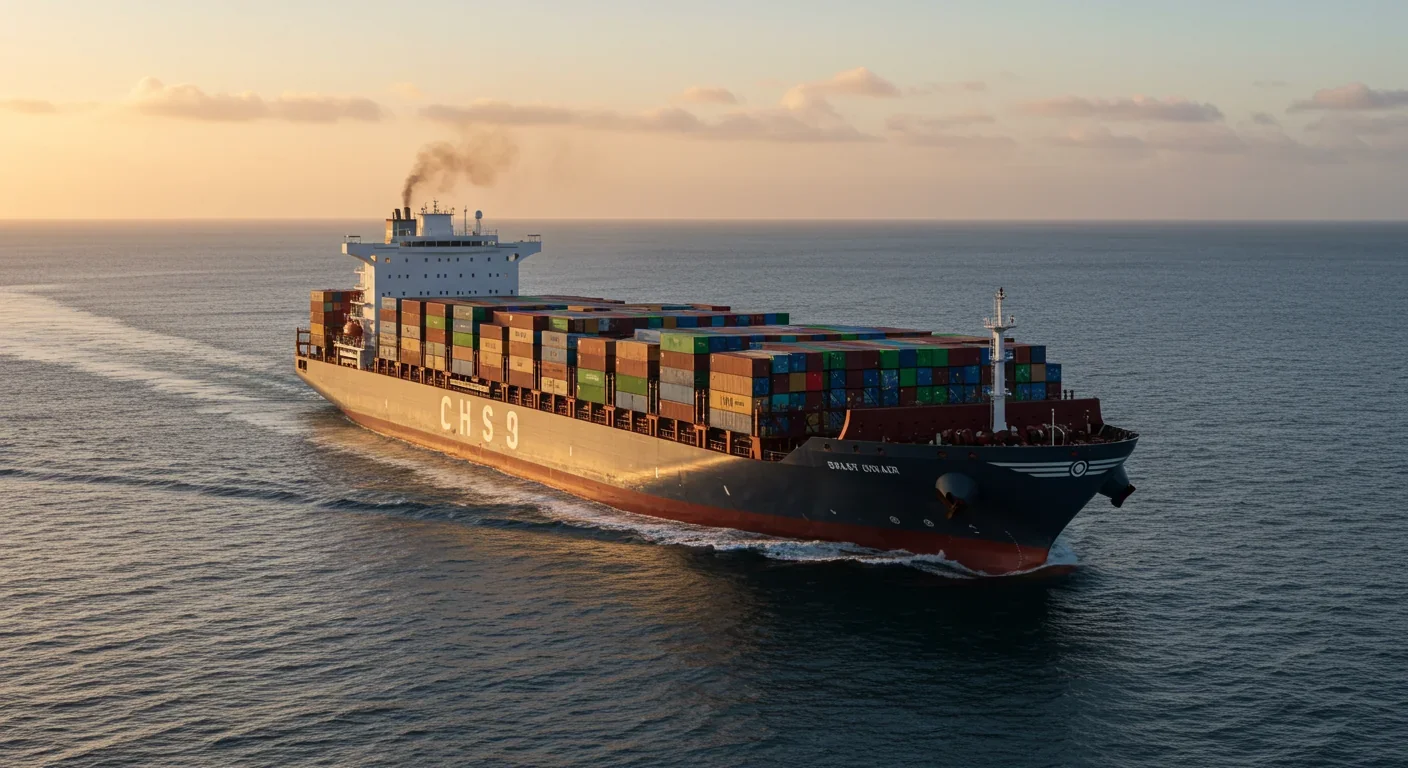
TL;DR: Intercropping boosts farm yields by 20-50% by growing multiple crops together, using complementary resource use, nitrogen fixation, and pest suppression to build resilience against climate shocks while reducing costs.
Picture a field where corn towers over nitrogen-fixing peanuts, while the peanuts quietly enrich the soil below. Across the way, watermelons sprawl between rows of okra and cowpea, each plant playing a specific role in a carefully orchestrated ecosystem. This isn't experimental agriculture or some back-to-the-land fantasy. It's intercropping, and it's helping farmers around the world increase their harvests by 20-50% without expanding their land by a single acre.
At a time when climate shocks threaten food security and farmers face mounting pressure to produce more with less, intercropping represents a deceptively simple solution: grow multiple crops together in the same field. The results are compelling enough that agricultural scientists are calling it one of the most effective strategies for building resilience into farming systems.

When researchers measure intercropping's effectiveness, they use something called the Land Equivalent Ratio (LER). If your LER is 1.32, it means you're getting 32% more total yield from intercropped land than you would from the same area planted as separate monocultures. And those aren't theoretical numbers.
A recent study on cardoon-safflower intercropping documented an LER of 1.32, translating to a 32% yield advantage. In Texas, researchers found that peanut-watermelon-okra-cowpea combinations consistently achieved LER values between 1.17 and 1.20 across multiple growing seasons. In Northeast China, maize yields jumped 33.45% when intercropped with peanuts, even though peanut yields dipped slightly.
Intercropping isn't about every crop producing more. It's about the system as a whole becoming more productive because the crops complement each other in ways that monocultures simply can't.
That last point matters. Intercropping isn't about every crop producing more. It's about the system as a whole becoming more productive because the crops complement each other in ways that monocultures simply can't.
The beauty of intercropping lies in how it exploits differences between crops to squeeze more productivity from the same piece of ground.
Complementary resource use is the foundation. Corn develops deep roots that pull nutrients and water from lower soil layers, while shallow-rooted crops like peanuts focus on the top 15-20 centimeters. One study found that intercropped maize increased root length density by 69% in surface soil and 43% at deeper layers compared to monoculture. The plants aren't competing - they're dividing up the underground real estate.
Nitrogen fixation provides a built-in fertilizer factory. Legumes like peanuts, cowpeas, and pigeon peas host bacteria in their root nodules that convert atmospheric nitrogen into forms other plants can use. Research shows that legume-cereal intercropping systems can reduce synthetic nitrogen fertilizer needs by 20-40% while maintaining or increasing yields.
Pest and disease suppression happens almost automatically. Monocultures are like all-you-can-eat buffets for specialized pests. Intercropping disrupts their party by making host plants harder to find, providing habitat for beneficial insects, and creating physical barriers to pest movement. The biodiversity alone acts as insurance against catastrophic losses.
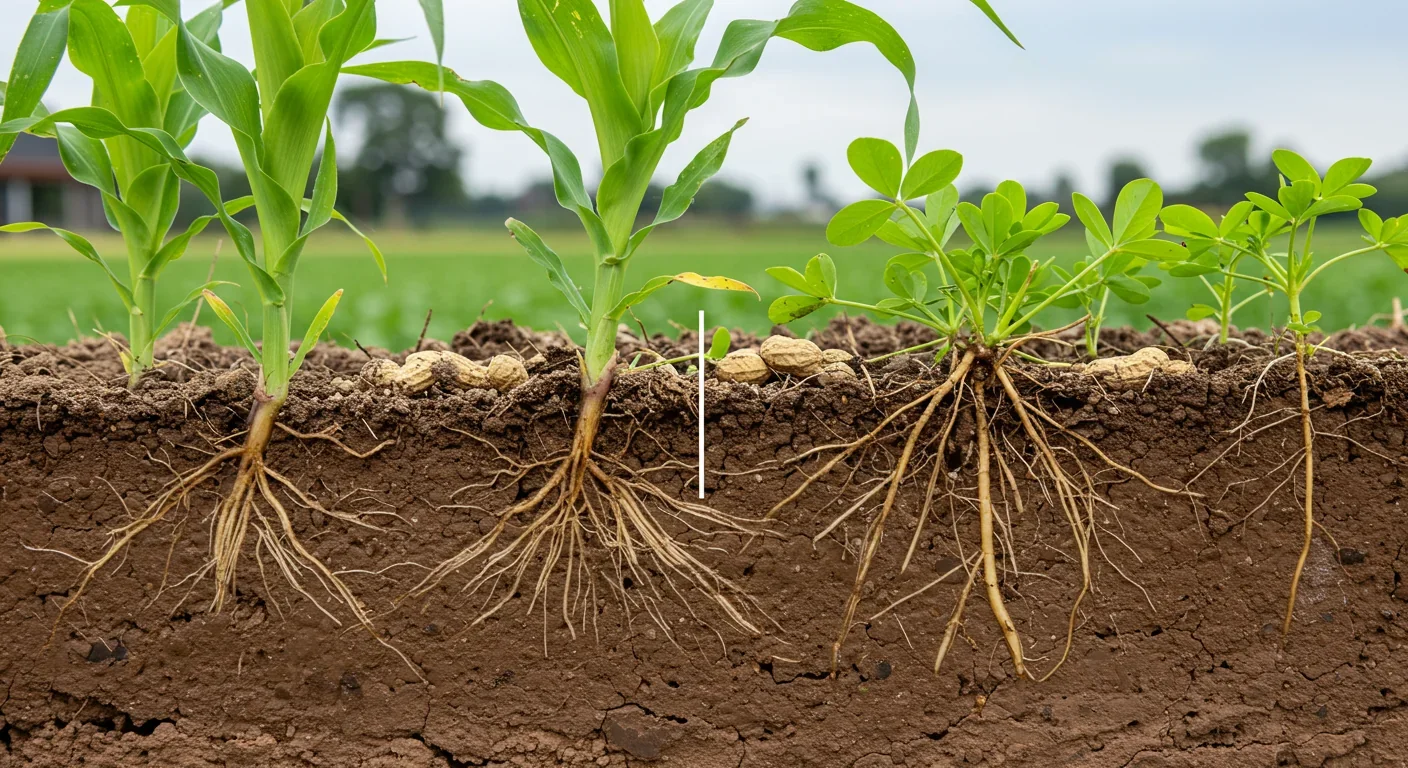
Microclimate modification is the subtle fourth mechanism. Taller crops provide shade that reduces water evaporation and moderates temperature extremes for shorter companions. In arid regions, this microclimate buffering can mean the difference between a failed crop and a harvest during drought years.
The most successful intercropping systems match crops with complementary characteristics to specific environmental challenges.
In semi-arid regions, the maize-pigeon pea combination has become a cornerstone of climate-smart agriculture. The pigeon pea's deep taproot accesses water beyond maize's reach, while its nitrogen fixation reduces fertilizer costs. Farmers in East Africa report that this pairing maintains yields even when rainfall drops 20-30% below normal.
For intensive vegetable production, the peanut-watermelon-okra system developed in Texas shows remarkable versatility. Watermelon production per plant jumped from 2.09 kg to 5.50 kg in intercropped systems, while okra yields increased by over 100%. The key is careful timing - watermelon dominates early in the season before okra takes over as temperatures rise.
"The intercropped cardoon and safflower system achieved a land equivalent ratio (LER) of 1.32, indicating a 32% yield advantage."
— Research study, MDPI Agriculture
In Northeast Asia, maize-peanut intercropping has spread rapidly because it works with existing mechanization. The maize harvest happens first, then peanuts are gathered separately. Border-row effects create enhanced growing conditions where the two crops meet, with both species showing increased root exploration and nutrient uptake.
Agroforestry intercropping takes a longer view. Wheat intercropped with alfalfa not only increases immediate yields but improves soil structure and reduces salinity over multiple seasons. The perennial alfalfa roots create channels that improve water infiltration, while their nitrogen fixation continues benefiting subsequent crops.
Water scarcity is rewriting the rules of agriculture, and intercropping offers a compelling response. The numbers are striking: water-use efficiency in intercropped systems typically exceeds monocultures by 18-99%, depending on crop combinations and climate conditions.
How does this work? Start with the fact that intercrops maintain soil cover longer throughout the growing season, reducing evaporation. Add in the complementary rooting depths that extract water from different soil zones. Layer on the microclimate effects that reduce plant stress. The result is a system that produces more food per drop of water.
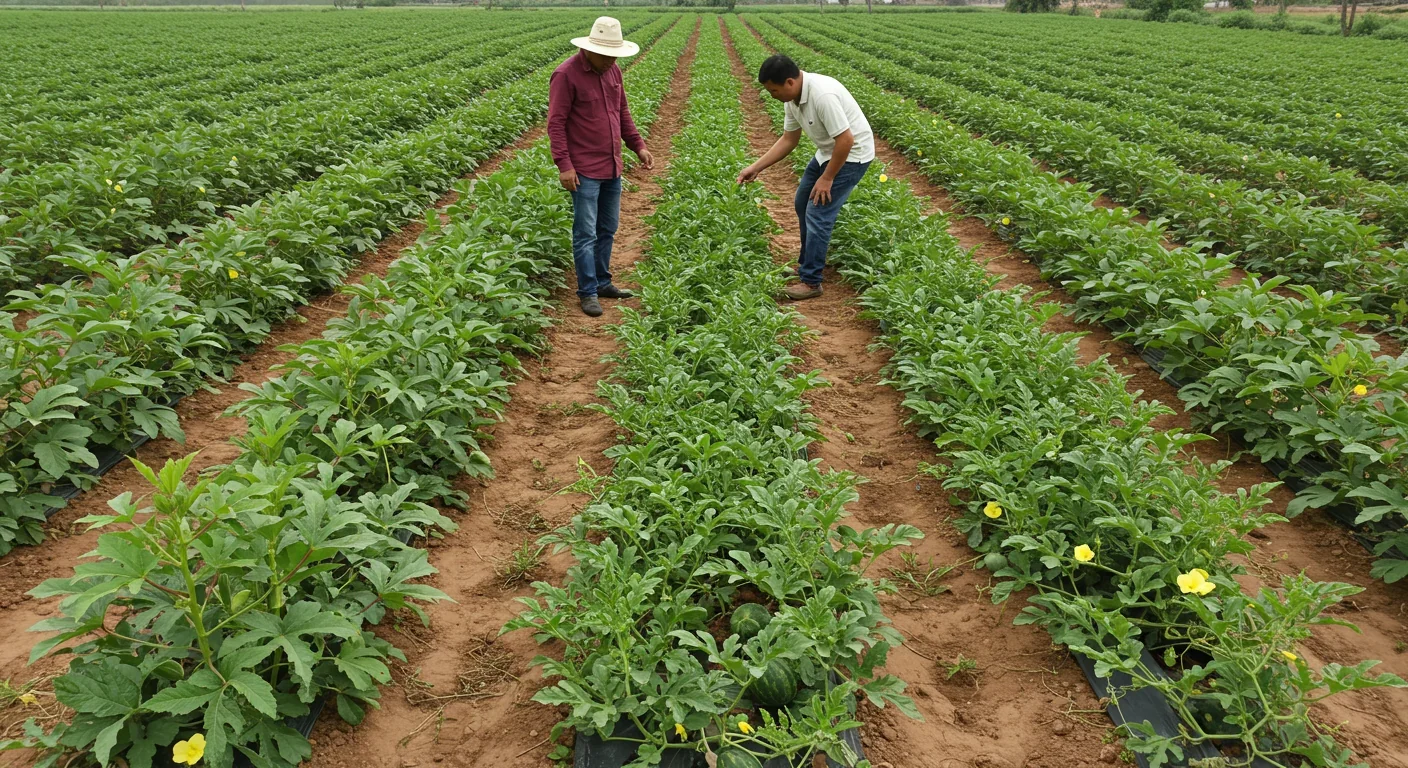
Studies across five moisture levels - from 297 to 584 mm of applied water - found that intercrops consistently overyielded monocultures at every water availability level. This matters enormously because it means intercropping provides benefits in both water-scarce and water-adequate conditions. You're not just optimizing for drought; you're building a system that performs better across the full range of conditions farmers actually face.
Drought resilience goes beyond water-use efficiency. When one crop in an intercropped system suffers stress, companion crops often compensate by increasing their own growth. This response buffering provides a yield safety net that monocultures lack. A farmer might lose 40% of their maize yield to drought but still harvest a full peanut crop, resulting in a combined loss of perhaps 15-20% instead of a total failure.
Yield advantages mean little if costs eat up the gains. So what does the economic picture look like?
Harvesting costs for intercropped cardoon-safflower systems came in at 85 EUR per hectare, slightly less than monoculture operations. Total production costs were 1,241 EUR per hectare - competitive with conventional farming. When you combine similar costs with 30-50% higher yields, the profit advantage becomes clear.
But the economic benefits extend beyond just higher output. Risk diversification might be intercropping's most valuable financial feature. Market prices fluctuate, often dramatically. When you grow multiple crops, a price collapse in one market is balanced by stable or strong prices in another. You're not putting all your economic eggs in one basket.
Risk diversification might be intercropping's most valuable financial feature. When you grow multiple crops, a price collapse in one market is balanced by stable or strong prices in another.
Insurance against crop failure works the same way. Pests, diseases, weather extremes - each tends to affect some crops more than others. Intercropped farmers consistently report that partial losses in one crop are offset by full harvests in companions. Over a decade, this risk spreading can mean the difference between staying in business and going under.
Labor efficiency varies by system but generally favors intercropping. Planting, management, and harvest tasks are often spread across a longer season, smoothing out labor demands rather than creating the intense peaks that monoculture requires. For small-scale farmers without access to large labor pools, this temporal spreading of work is a significant operational advantage.
The soil health benefits create longer-term economic value that's harder to quantify but very real. Legume intercropping builds soil nitrogen, reducing fertilizer expenses in subsequent seasons. Improved soil structure from diverse root systems increases water infiltration and reduces erosion. These cumulative benefits compound over years, making farms more productive and less dependent on external inputs.
Climate change isn't just about water. It's about variability, unpredictability, and extreme events becoming normal. Intercropping addresses these challenges through multiple pathways.
Temperature extremes hit monocultures hard because every plant has the same vulnerabilities. In intercropped systems, taller crops moderate temperatures for shorter companions. Research shows that understory crops in intercropped systems experience 2-4°C lower maximum temperatures during heat waves, often enough to prevent heat stress and maintain photosynthesis.
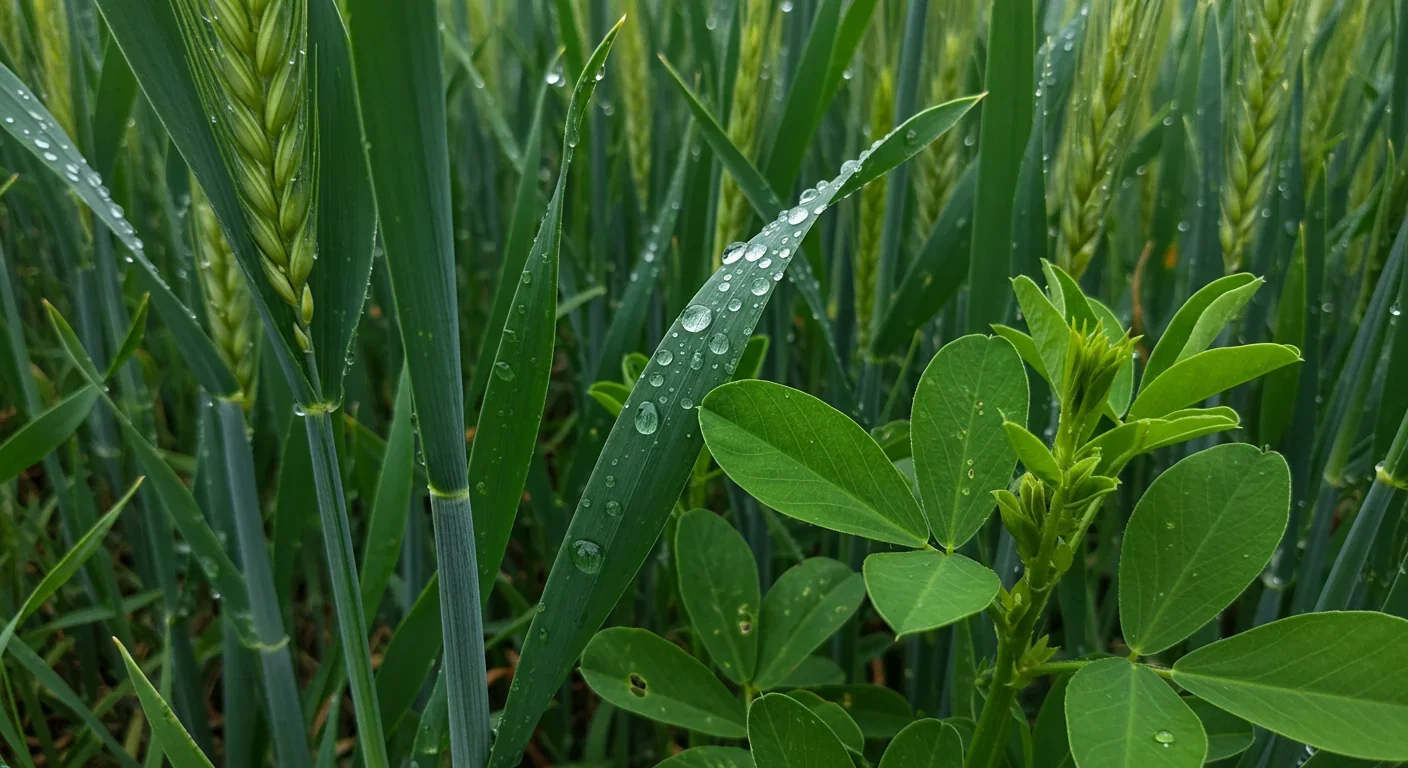
Pest and disease outbreaks are projected to become more severe and unpredictable as climate patterns shift. Biodiversity-based pest suppression becomes more valuable, not less, in this context. A meta-analysis of cropping practices found that diversified systems consistently showed lower pest damage across varying environmental conditions.
Soil degradation accelerates under climate stress, creating a vicious cycle. Intercropping interrupts this cycle. Continuous ground cover protects soil from erosion during intense rainfall events. Diverse root systems prevent compaction and maintain soil structure. The result is soil that retains productivity even as weather becomes more erratic.
Market volatility follows environmental volatility. When regional crop failures drive price spikes, farmers with diversified production can capitalize on high prices for some crops while still feeding their families or maintaining revenue from others. This economic buffering might be intercropping's most important climate adaptation benefit.
Theory meets practice in thousands of fields worldwide where farmers have adopted intercropping and stuck with it. Their experiences reveal both the potential and the practical challenges.
In Malawi, smallholder farmers growing maize-pigeon pea combinations report that they can maintain maize yields while adding 200-400 kg of protein-rich pigeon peas per hectare. The pigeon peas provide family nutrition and generate cash income, while nitrogen fixation reduces fertilizer needs for subsequent maize crops. Adoption has spread farmer-to-farmer because the benefits are visible and immediate.
In India's semi-arid regions, cotton-pigeon pea intercropping has become standard practice among progressive farmers. They've learned that the pigeon pea canopy suppresses weeds during cotton's vulnerable early growth, reducing labor costs. When pink bollworm attacks cotton, the pigeon pea crop still matures. Farmers describe it as "growing with a safety net."
"Three and four species intercropping combinations consistently overyielded with LER values of 1.17 each in 2011 and 1.17-1.20 in 2012."
— Agricultural research study, Texas
Mechanization challenges have slowed intercropping adoption in large-scale agriculture, but innovation is catching up. Adapted combine harvesters can now handle some intercropped systems, achieving 85% field efficiency. The key is selecting crop combinations with compatible harvest timing or developing specialized equipment for simultaneous harvest.
In China's Gansu Province, wheat-maize relay intercropping covers millions of hectares. Farmers plant maize between wheat rows about six weeks before wheat harvest. The wheat provides early income while maize is still establishing. After wheat harvest, maize has the full field. This temporal intercropping extends the growing season and produces two main crops where climate allows only one traditional crop cycle.
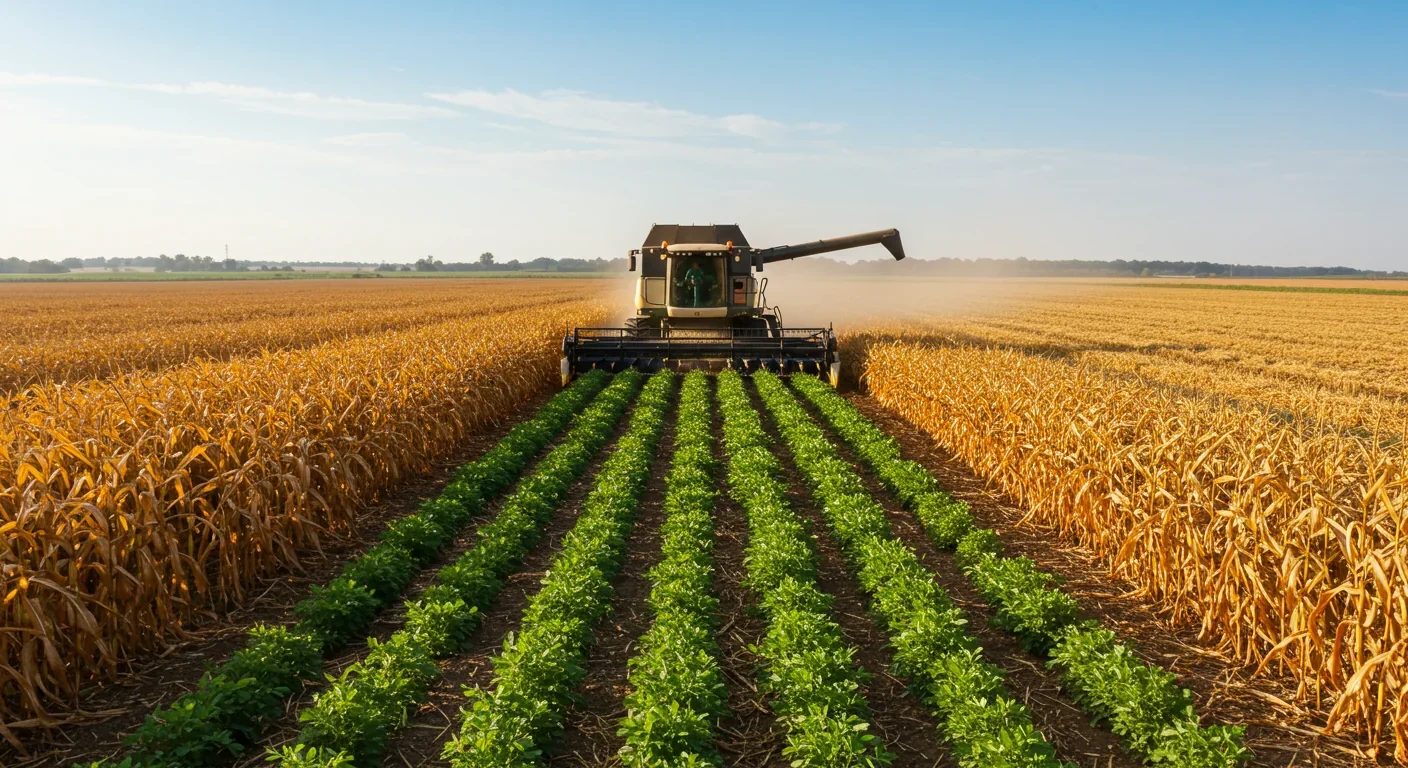
Home gardeners and small-scale farmers often achieve the most dramatic intercropping benefits because they can manage spatial complexity that large operations struggle with. The three sisters system - corn, beans, and squash - remains productive because it doesn't require specialized machinery. Beans climb corn stalks, squash shades out weeds, and all three benefit from complementary resource use.
Enthusiasm needs to be tempered with realism about what makes intercropping difficult.
Knowledge intensity tops the list. You're not just managing one crop's growth cycle, pest profile, and nutrient needs. You're managing multiple crops simultaneously, along with their interactions. The learning curve is steep. Extension services in many regions lack intercropping expertise, leaving farmers to experiment and learn from mistakes.
Mechanization limitations remain the biggest barrier to widespread adoption on large farms. Most agricultural equipment is optimized for monoculture. Planters, cultivators, and especially harvesters struggle with spatial complexity. Some progress is being made, but farmers often face a choice between labor-intensive hand work and abandoning intercropping altogether.
Market access can work against you. Commodity markets are built around large, uniform lots. Buyers want truckloads of soybeans, not a mix of soybeans and sorghum. Farmers who intercrop may face lower prices or difficulty finding buyers, even though their combined yields are higher. This market structure issue requires either on-farm processing or development of new market channels.
Timing complexity increases management demands. Different crops have different planting dates, maturity periods, and harvest windows. Get the timing wrong and you lose the complementarity benefits. Relay intercropping systems require precise coordination - plant the second crop too early and it competes with the first; too late and you miss the growing window.
Variety selection matters enormously but information is scarce. Which corn varieties work best with beans? What peanut varieties have growth habits compatible with maize? Seed companies develop varieties for monoculture performance. Farmers need to test and adapt, often without guidance.
Input management becomes more complex. If you apply herbicide to control weeds in maize, will it harm your intercropped beans? Irrigation timing that suits one crop might be wrong for another. Pest management requires understanding how insects move through a diverse canopy. Each decision point multiplies.
Scale matters differently than in monoculture. Some intercropping systems are highly profitable at 2-5 hectares but struggle at 200 hectares. Others are only economical at larger scale. Farmers need to match their intercropping strategy to their operational scale and available labor.
If you're considering intercropping, start small and build systematically.
Begin with proven combinations for your region and climate. Don't experiment with novel crop pairings on your main acreage. Maize-legume systems work across a wide range of conditions and have established management guidelines. In vegetable production, tomato-basil or cabbage-lettuce combinations offer lower-risk entry points.
Allocate 10-20% of your land to intercropping trials in the first year. This gives you enough area to evaluate results without risking your entire operation. Track yields, costs, and labor time carefully. Compare against your monoculture fields, not against idealized projections.
Focus on complementarity when selecting crops. Match deep-rooted with shallow-rooted, early-maturing with late-maturing, nitrogen-fixers with nitrogen-demanding crops. The biological logic should be clear before you plant. If you can't explain why two crops should work together, they probably won't.
Adjust planting patterns based on experience. Row spacing, plant density, and spatial arrangement dramatically affect results. Border-row effects where crops meet create enhanced growing conditions, so experiment with row configurations to maximize these edge zones.
Monitor continuously throughout the season. Watch for unexpected competition or complementarity. Note which crops dominate at different growth stages. Document what works so you can repeat success and avoid repeating failures.
Connect with other farmers practicing intercropping. Local knowledge is often more valuable than research papers because it's adapted to your specific conditions. Farmer field schools and demonstration plots accelerate the learning process.
Consider your market before you plant. Line up buyers for all your crops. If you're growing for home consumption, plan meals around what you'll harvest. The productivity benefits of intercropping evaporate if you can't use or sell what you grow.
The debate between monoculture and intercropping isn't about one being universally superior. Each has domains where it excels.
Monoculture advantages are real and shouldn't be dismissed. Mechanization is straightforward. Management is simpler. Market access is easier. For large-scale commodity production with access to capital and inputs, monoculture can be highly profitable. The industrial agriculture model is built around it.
But monoculture vulnerabilities are becoming more apparent. Climate variability hits harder. Pest resistance to pesticides is accelerating. Soil degradation compounds. Market price swings create boom-bust cycles. The question isn't whether monoculture works - obviously it does - but whether it will continue working as reliably as environmental and economic conditions shift.
Intercropping offers different trade-offs. You give up some mechanization efficiency and management simplicity. In return, you get enhanced resilience, resource-use efficiency, and risk spreading. These benefits compound over time. A comprehensive review found that diversified cropping systems maintain productivity more consistently across varying conditions than monocultures.
Land-use efficiency is where intercropping clearly dominates. An LER of 1.3 means you'd need 30% more land in monoculture to match intercropped output. As agricultural land becomes scarcer and more valuable, this efficiency advantage becomes decisive.
Input efficiency - water, nutrients, pesticides - similarly favors intercropping. When resources are cheap and abundant, monoculture's higher inputs don't matter much. As inputs become expensive or scarce, intercropping's efficiency in using them becomes economically compelling.
The future likely involves both approaches, deployed strategically. Large-scale grain production will remain predominantly monoculture where mechanization and markets favor it. Diversified production systems will expand where resilience matters more than maximum efficiency in any single crop. Farmers will increasingly treat monoculture and intercropping as tools to be applied where each fits best.
Beneath all the yield discussions lies something more fundamental: what intercropping does to soil over time.
Biological nitrogen fixation from legumes adds 40-200 kg of nitrogen per hectare annually, depending on species and growing conditions. This isn't just free fertilizer for the current crop. It builds soil nitrogen reserves that benefit subsequent crops for years.
Soil organic matter increases under intercropping because diverse root systems produce more total biomass below ground. Different root architectures create channels at different depths, improving soil structure and water infiltration. As roots decompose, they feed soil microbes and build long-term fertility.
Erosion control improves dramatically. Continuous canopy cover protects soil from raindrop impact. Diverse root systems bind soil more effectively than single-crop root mats. On sloping land, this erosion reduction can prevent catastrophic soil loss during extreme rainfall events.
Soil biology flourishes in intercropped systems. Microbial diversity increases because different crops release different root exudates, feeding different microbial communities. This biological diversity enhances nutrient cycling, disease suppression, and soil structure formation.
Carbon sequestration benefits are substantial though still being quantified. More root biomass means more carbon stored below ground. Reduced tillage in perennial intercropping systems preserves existing soil carbon. Over decades, this accumulation makes farms net carbon sinks rather than sources.
Agricultural technology tends to follow one of two paths: intensification through external inputs or optimization through ecological design. Intercropping clearly belongs to the second category.
Research priorities are shifting to address the knowledge and mechanization gaps that limit adoption. Plant breeders are beginning to develop varieties specifically optimized for intercropping rather than monoculture. Computer modeling helps predict which crop combinations will work in specific environments without years of trial-and-error.
Precision agriculture tools offer new possibilities. Variable-rate planters can place different crops in optimal spatial patterns. Sensors can monitor multiple crops simultaneously and guide targeted interventions. Autonomous machinery might handle complexity that defeats conventional equipment.
Policy support is growing as governments recognize intercropping's contributions to food security and climate adaptation. Subsidy programs increasingly reward diversification. Agricultural extension services are developing intercropping expertise. This institutional support accelerates adoption beyond early-adopter farmers.
Climate change will likely drive broader acceptance. As weather becomes less predictable and extreme events more common, the resilience advantages of diversified systems become impossible to ignore. Farmers manage risk, and intercropping is fundamentally a risk-reduction strategy that happens to increase productivity.
The trajectory seems clear. Intercropping won't replace monoculture entirely, but it will claim an expanding share of global agricultural land. Farmers who master it will be better positioned to thrive in an increasingly uncertain climate. Those who don't may find themselves wishing they'd started learning sooner.
The evidence for intercropping isn't theoretical anymore. Thousands of farmers worldwide are achieving 20-50% yield increases while building more resilient farming systems. The transition requires learning new skills and accepting increased management complexity, but the benefits - higher productivity, better resource efficiency, reduced risk, and improved soil health - make a compelling case.
If you're farming conventionally and wondering whether intercropping makes sense for you, the answer is probably yes. Start with a small trial area. Choose proven crop combinations. Track your results carefully. Learn from both successes and failures. Connect with other farmers making the transition.
The farms that will thrive over the next few decades won't necessarily be the biggest or most technologically advanced. They'll be the ones that work with ecological principles rather than against them, building resilience into every decision. Intercropping offers a practical path toward that future - one that's available to farmers of any scale, anywhere in the world.
The question isn't whether intercropping works. The research has settled that. The question is whether you're ready to put it to work on your land.

Curiosity rover detects mysterious methane spikes on Mars that vanish within hours, defying atmospheric models. Scientists debate whether the source is hidden microbial life or geological processes, while new research reveals UV-activated dust rapidly destroys the gas.

CMA is a selective cellular cleanup system that targets damaged proteins for degradation. As we age, CMA declines—leading to toxic protein accumulation and neurodegeneration. Scientists are developing therapies to restore CMA function and potentially prevent brain diseases.

Intercropping boosts farm yields by 20-50% by growing multiple crops together, using complementary resource use, nitrogen fixation, and pest suppression to build resilience against climate shocks while reducing costs.

The Baader-Meinhof phenomenon explains why newly learned information suddenly seems everywhere. This frequency illusion results from selective attention and confirmation bias—adaptive evolutionary mechanisms now amplified by social media algorithms.
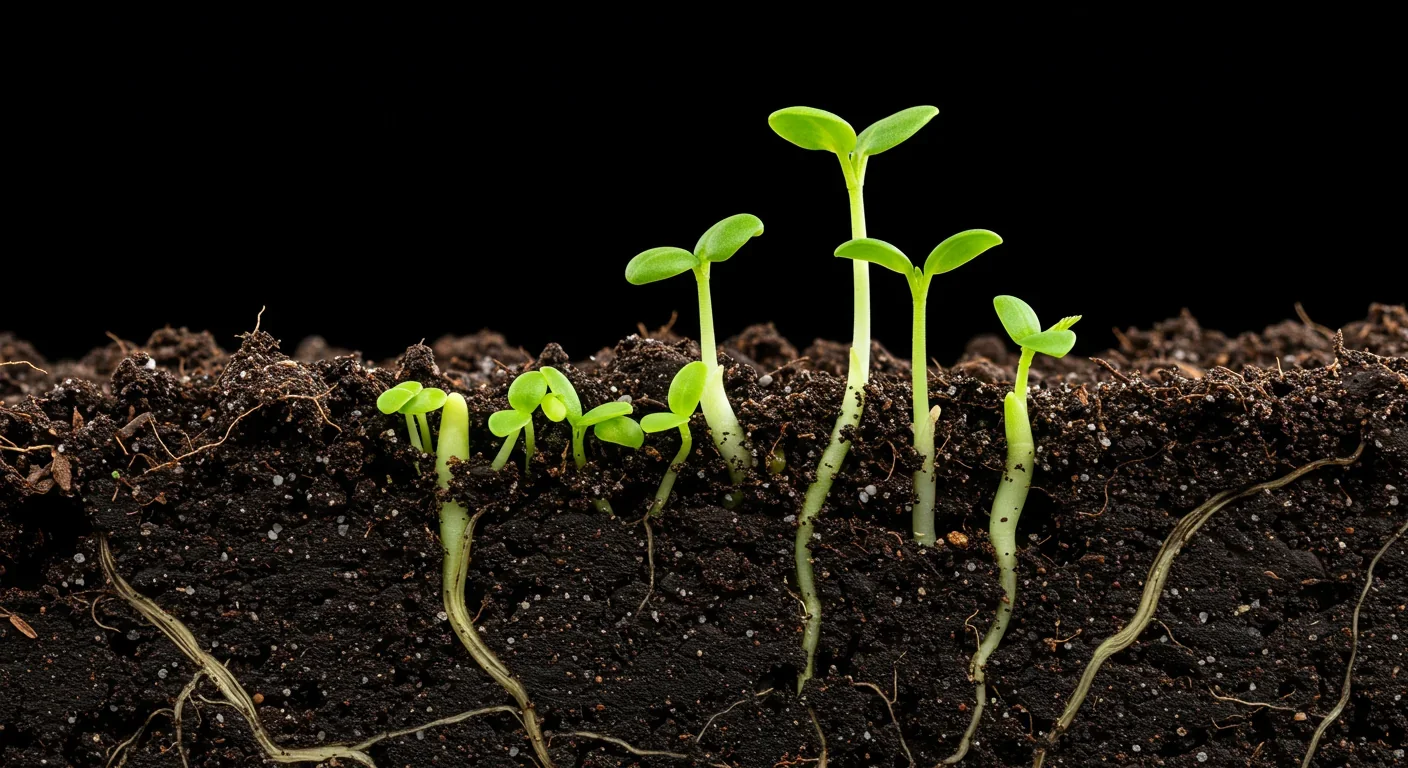
Plants and soil microbes form powerful partnerships that can clean contaminated soil at a fraction of traditional costs. These phytoremediation networks use biological processes to extract, degrade, or stabilize toxic pollutants, offering a sustainable alternative to excavation for brownfields and agricultural land.

Renters pay mortgage-equivalent amounts but build zero wealth, creating a 40x wealth gap with homeowners. Institutional investors have transformed housing into a wealth extraction mechanism where working families transfer $720,000+ over 30 years while property owners accumulate equity and generational wealth.

AlphaGo revolutionized AI by defeating world champion Lee Sedol through reinforcement learning and neural networks. Its successor, AlphaGo Zero, learned purely through self-play, discovering strategies superior to millennia of human knowledge—opening new frontiers in AI applications across healthcare, robotics, and optimization.